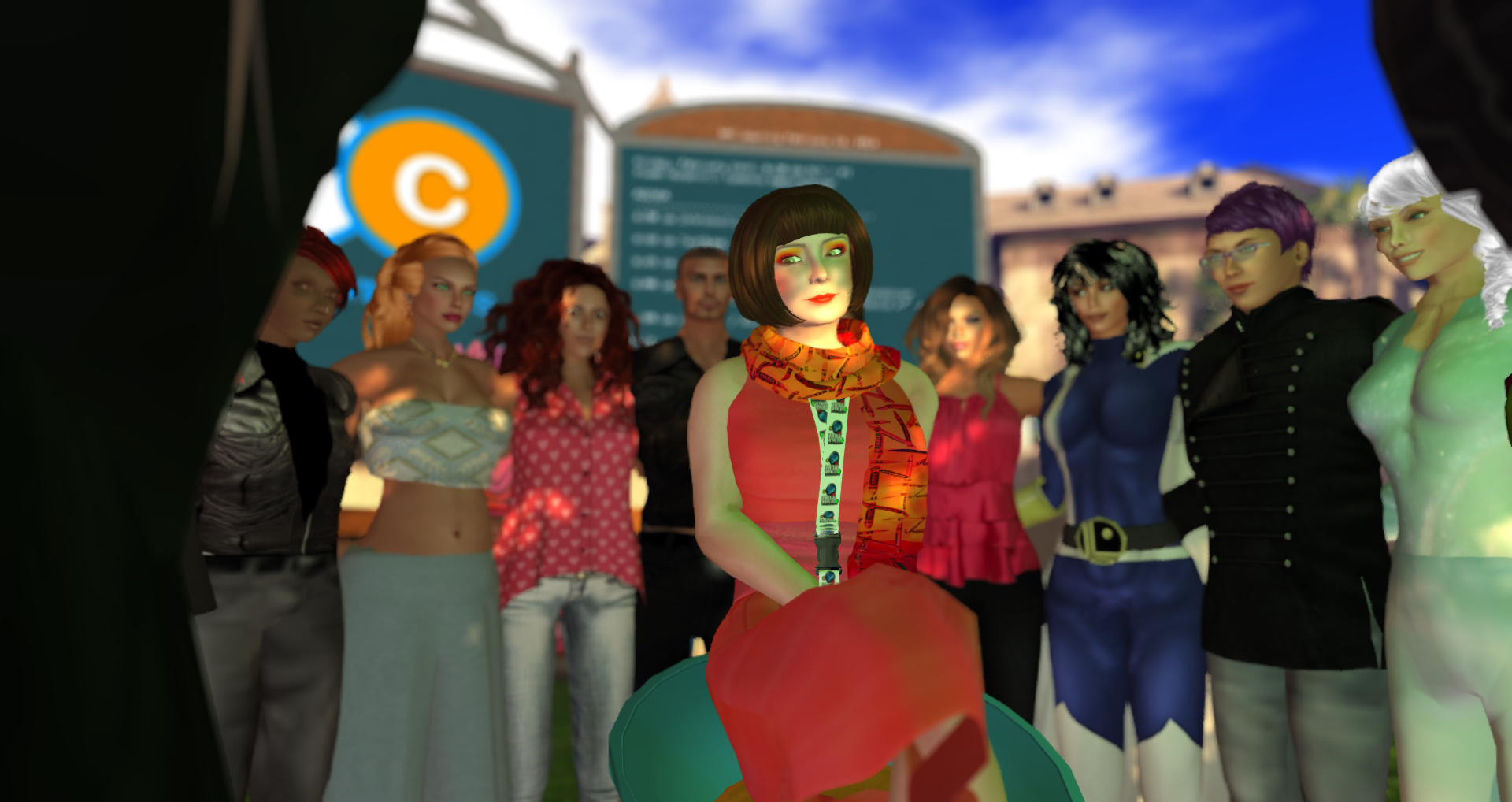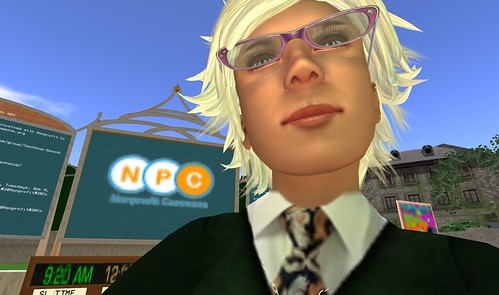Although Namaara MacMoragh is a happy and fulfilled consultant at GReat Kreations, an organization dedicated to developing “organizational capacity through information technology and information management, strategic planning, board training, and systems development” for nonprofit organizations in the US, it was the work she does for Brain Energy Support Team (BEST), that brought her before the Nonprofit Commons last Friday, March 2nd.
BEST is a wonderful group that has been providing peer-to-peer support, resources, and access to services for those with brain injuries in the real and Second Life worlds since 2008. Implementing unique ways for recovering patients, BEST’s primary modus operandi is to include the friends and family of the injured, making them a central role and active participant in the recovery process.
More about BEST and the work Namaara does with them in her presentation below…
Namaara MacMoragh: BEST is a leader in training for support group facilitators, professionals, and educators. Through their mentoring program, Project PEER, BEST also offers a unique way of empowering individuals with brain injury and their caregivers.
Namaara MacMoragh: Our goal is to create engagement around the real issues of brain injury that go beyond the injury itself. An injury occurs in a moment. The cognitive, emotional, physical challenges that alter someone’s life often last for many years and often go unaddressed.
Namaara MacMoragh: Second Life offered us an opportunity to work together building an organizational foundation for BEST while living 3,000 miles apart. It was 6 months after we began working together in SL that we actually met in RL for a board training session in 2009.
Namaara MacMoragh: March is the official month for Brain Injury Awareness. BEST, Etopia, and the fabulous folks at HealthInfo Island have worked together to create a celebration and awareness campaign that includes presentations, displays, concerts, gift hunt, and more to raise awareness about, and raise dollars for, brain injury.
Namaara MacMoragh: We are collaborating with others in SL who are providing support, information & referral, and social opportunities for individuals with brain injury as well as training and resources for professionals and educators.
Namaara MacMoragh: I’m especially excited to work with Gentle Heron of Virtual Abilities. I’ve learned a lot and so appreciate the ideas, support, and … well … at the expense of gushing… everything. As an aside, it’s been wonderful to watch the growth of such a valuable organization here in SL.
Namaara MacMoragh: Thank you again, Gentle, for the wonderful slide presentation about brain injury. I hope everyone will visit HealthInfo Island to learn about brain injury and more.
Namaara MacMoragh: Another great relationship that has been forged because of our work in Second Life is with Zinnia Zauber. She is working with BEST to create an original branding element (hope I said that right) for the hospital bags BEST and Headstrong are giving families of individuals that are hospitalized with brain injury.
Namaara MacMoragh: These collaborations would not have happened without a community such as Nonprofit Commons in Second Life and the commitment of TechSoup Global to support and foster nonprofits around the world. I was living in NY when I started working with fate. Zinnia and Gentle are also in other locations than in my neighborhood.
Namaara MacMoragh: We have a lot of great events, presentations, displays, and builds across sims we are highlighting during Brain Injury Awareness month and throughout April and May, with a huge World-wide brain injury picnic day on June 16th.
Namaara MacMoragh: This is our collective opportunity to also showcase the work we do here to families, professionals, and funders.
Namaara MacMoragh: When I started working with BEST we had a shoestring budget. BEST then became lead on a Support Group Infrastructure Project in the state of Washington.
Namaara MacMoragh: This year they received independent funding from the state to not only continue their work with support group development, but to administer mini-grants to groups across the state. This increase in funding is because of the way BEST has used SL and other virtual work tools to communicate, train, and support facilitators and others.
Namaara MacMoragh: These are just some of the ways we work with real people on real issues in virtual worlds.
And now, some virtual world knowledge from Mentor’s Central. Last Friday’s topic: benefits people with disabilities get from being in a virtual world.
Eme Capalini: Just a quick reminder of why this is an important topic. One out of every five avatars you meet in SL belongs to someone with one or more disabilities – physical, mental, emotional, or sensory.
Eme Capalini: Until recently, when we spoke of the benefits of virtual worlds, we mainly had anecdotal evidence in four categories.
Eme Capalini: I’m going to share with you some quotes I’ve heard from our community members that fit into these categories.
Eme Capalini: Learning benefits abound in Second Life.
Eme Capalini: Although people don’t typically come into SL seeking peer support for their disability, once they hook up with one of the over 120 different peer support groups here, they can learn quite a lot!
Eme Capalini: You might not think of distraction as a benefit, but to people with severe disabilities, getting their mind off their pain is important.
Eme Capalini: Doctors in burn clinics use virtual ice worlds, where the patient can throw snowballs at penguins and ice gnomes, to distract the patients from the agony of burn debridement, bandage changes, and the other painful treatments they must undergo.
Eme Capalini: For medical benefits, there has been some research, so the evidence of benefits isn’t just anecdotal.
Eme Capalini: Researchers confirm that people can improve their concentration, their social skills, even their spatial awareness, simply by interacting with others in a virtual world setting.
Eme Capalini: I think that social benefits are probably the most important to people with disabilities, who are often socially and physically isolated. Imagine being able to make friends with people your own age when you’ve spent half your life lying in bed seeing only your family and nurses!
Eme Capalini: It’s a lot easier to “be yourself” around other people if they aren’t put off by seeing your scars or withered limbs.
Eme Capalini: We’re finally making progress on gathering research evidence to support what we hear from our community members.
Eme Capalini: The psychology department at Loyola Marymount University in California recently gave a poster presentation about research they conducted in collaboration with Virtual Ability.
Eme Capalini: The research consisted of a survey given to people who identified themselves as having a disability. The survey was given during their first week in Second Life, and repeated after 3 months here.
Eme Capalini: It was a small study, but the results are significant, as they are the first of their kind to be done in SL.
Eme Capalini: Participants in the study completed a variety of standardized measures that were selected to assess their psychological well-being and adjustment.
Eme Capalini: There was no treatment in this study. The participants didn’t have to attend classes, report in regularly, keep a diary, or anything else regulated. They could do whatever they pleased.
Eme Capalini: The majority logged in frequently, and for extended periods. They became immersed in their second lives.
Eme Capalini: When they first came into SL, the measures indicated that the majority of participants showed clinical signs of depression. That’s not unexpected, in a group of people among whom half were severely disabled.
Eme Capalini: Overall, the research showed that simply being in a virtual world, doing whatever you wanted to do, was very helpful. Statistically, the newcomers after 3 months were less depressed, less anxious, and less lonely.
Eme Capalini: They also were had a more positive outlook on themselves, were more satisfied with their lives, and had higher self-esteem.
Eme Capalini: I’d like to encourage you to think about all the benefits you’ve received from being in a virtual world.
Following Eme’s request, I’m taking a moment to do just that. What are some of the benefits you’ve seen in your own lives?
Written by: alebez


